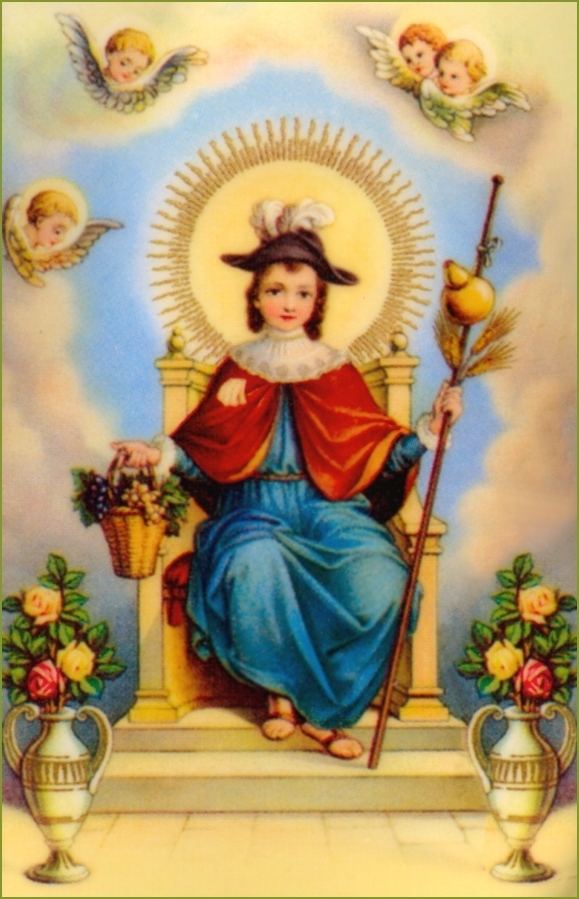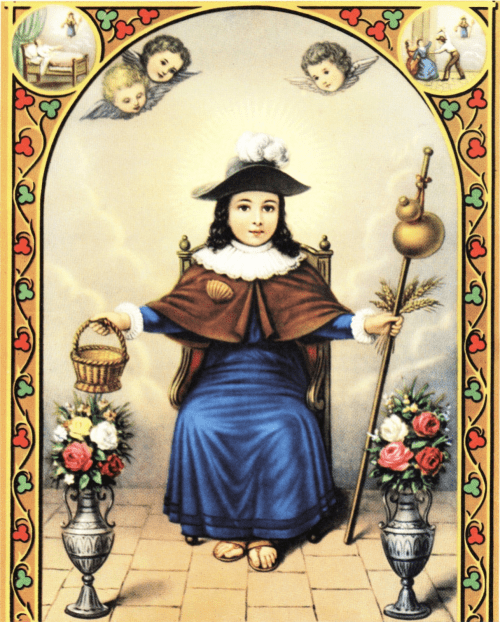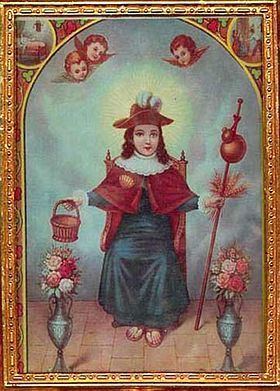Date 13th century | ||
 | ||
Attributes Brown cloak, blue robe, feathered hat, basket, staff, water gourde | ||
Visitando al santo ni o de atocha plateros zacatecas
Holy Infant of Atocha or Santo Niño de Atocha is a Roman Catholic image of the Christ Child popular among the Hispanic cultures of Spain, Latin America and the southwestern United States. It is distinctly characterized by a basket he carries, along with a staff, drinking gourd, and a cape affixed to which is a scallop shell, symbol of a pilgrimage to Saint James.
Contents
- Visitando al santo ni o de atocha plateros zacatecas
- History
- Description
- Devotion beyond Atocha
- Mexico and New Mexico
- The Philippines
- References

History

Devotion to Holy Infant of Atocha originally began as a Marian devotion with a medieval statue of the Madonna and Child in Toledo, Spain. According to Juan Javier Pescador, it originally reflected devotions to three different depictions of the Virgin Mary: Our Lady of Atocha, Our Lady of Antigua, and Our Lady of Pregnancies that later coalesced into Our Lady of Atocha.

The image of the Divine Child was detachable, and devout families would often borrow the image of the infant when a woman was about to give birth to her child.

In the 13th century, Spain was under Muslim rule. The town of Atocha, now part of Madrid's Arganzuela district, was lost to the Muslims, and many Christians there were taken prisoners as spoils of war. The Christian prisoners were not fed by the jailers, but by family members who brought them food. According to pious legend, the caliph ordered that only children under the age of 12 were permitted to bring food. Conditions became increasingly difficult for those men without small children. The women of Atocha prayed before the statue of Our Lady of Atocha at a nearby parish, a title of the Blessed Virgin Mary, to ask her son Jesus for help.

Reports soon began among the people of Atocha that an unknown child under the age of twelve and dressed in pilgrim's clothing, had begun to bring food to childless prisoners at night. The women of the town returned to Our Lady of Atocha to thank the Virgin for her intercession, and noticed that the shoes worn by the Infant Jesus were tattered and dusty. They replaced the shoes of the Infant Jesus, but these became worn again. The people of Atocha took this as a sign that it was the Infant Jesus who went out every night to help those in need.
Description

The Holy Child of Atocha is depicted dressed as a boy pilgrim dressed in a brown cloak with white lace collar over a blue robe. He wears a brimmed hat with a plume and carries a basket full of bread in one hand and a pilgrim's staff in the other. The pilgrim's staff is often depicted with a water gourd fastened to it. On the cloak he wears a Shell of Saint James, symbol of the pilgrims to the Shrine of Santiago de Compostela in northwestern Spain. The Child is said to roam the hills and valleys, particularly at night, bringing aid and comfort to the needy, and thereby wearing out his shoes. He is usually shown seated.
Devotion beyond Atocha
The Moorish conflict extended well beyond the town of Atocha. During dire points in their journey, travelers reported that a young boy, dressed as a pilgrim, would come to them bringing food and other necessities. The boy would often travel with them until they were out of danger and then guide them to the safest roads to reach their destination. Pious legends continued to be developed and the miraculous Child later became considered to be the Child Jesus and was given the title the Holy Child of Atocha.
Mexico and New Mexico

There are two primary shrines to Niño de Atocha: at Fresnillo/Plateros in the state of Zacatecas, Mexico and Chimayo, New Mexico, USA. The original Mexican Niño de Atocha was installed in the church of Saint Augustine along with the silver Christ in 1554 not long after a silver strike in Plateros.
In those years silver was discovered in Fresnillo and mines were being opened in the mountains near the settlement. Within a few weeks of the opening of the mine of Fresnillo, there was an explosion and many miners were trapped. The wives of the miners went to the church of St. Augustine to pray for their husbands and noticed that the child on the image of Our Lady of Atocha was missing. At the same time, it was said that a child came to the trapped miners, gave them water and showed them the way out of the mine. Whenever there was a problem at the mine the child helped the miners in need. Each time this happened, the image of the child on the Virgin's arms was found to be dirty and his clothes had little holes in them. After that the Holy Child was taken off his mother's arms and put on a glass box for everyone to see. The Holy Child of Atocha has become a symbol of Zacatecas and the protector of miners. Many make pilgrimages to Plateros at Christmas to bring toys to the Holy Child.
The Philippines
Holy Infant of Atocha is also popular amongst the mostly Catholic Filipino people. The local variant, simply known as Santo Niño (Holy Child), is portrayed very similarly to the Spanish Atocha, except that it is always standing rather than sitting. He bears a staff with an attached bag or basket, which is usually filled with coins or candy, and he dons a pilgrim hat resembling the Atocha image.
The current Santo Niño found in many Filipino homes is traditionally dressed in either green or red garments. In Filipino Folk Catholicism, red garments are suited for images enshrined at home, while green ones are for those enshrined in business establishments; a common offering to the latter is a bowl filled with coins and sweets. In addition, many Filipinos customarily dress the Santo Niño in modern attire that reflect their professional roles, such as nurses, doctors, janitors, teachers and policemen, as a means of asking for his patronage. These customs relating to dress are also applied to replicas of the Santo Niño de Cebu, brought by Ferdinand Magellan to the islands in 1521, and the Infant Jesus of Prague.
